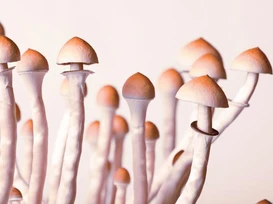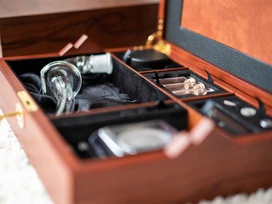‘Magic Mushrooms’ Classification: Psychedelic tryptamine

Safety Profile
A 2010 study done in the UK found psilocybin mushrooms to be the safest of 19 commonly used psychoactive substances. No one has ever died from ingesting psilocybin-containing ‘magic’ mushrooms. A lethal dose is said to be more than can fit into a human stomach if eaten in one sitting, but really a lethal dose has not been found yet.
Due to their illegality, psilocybin-containing mushrooms are not readily available to buy in most countries, yet grow wild all around the world. This may lead you to be tempted to go magic mushroom hunting, but of course, foraging for wild mushrooms is very dangerous unless you really know what you’re doing.
Overview
Psilocybin (O-phosphoryl-4-hydroxy-N,N-dimethyltryptamine) and psilocin (4-hydroxy-N,Ndimethyltryptamine, the metabolic product of psilocybin, are thought to produce the majority of psychedelic effects) are the primary psychoactive components of the naturally occurring ‘magic’ mushrooms and truffles that have been found growing on every continent on Earth except Antarctica. At least 245 species of the genus Psilocybe have been discovered to date.
There is evidence of human use of hallucinogenic mushrooms dating back to prehistoric times from rock art in Europe and Africa. The depiction of bemushroomed humanoids in the Tassili caves in Southern Algeria is between 7,000 and 9,000 years old, and it‘s difficult to conclude that they are communicating anything other than the psychedelic mushroom experience. There is also evidence of the ceremonial use of Psilocybe Mairei in Villar De Humo in Spain 6,000 years ago.
While it has not been proven, human use could reasonably go back much further than this. Its use could even have had a role in catalyzing the evolution of culture and language. There was extensive use of psilocybin mushrooms in South America. A mushroom statuette dating back to 200CE resembling Psilocybe Mexicana was found in Colima, Mexico.
Mushroom stones and motifs from 1000 – 500 BCE were found in Guatemala where they were likely used for religious communion, divination, and healing in Mesoamerica from pre-Columbian times. It was also used by the Mayan and Aztec civilizations and continues in Mexico among groups of Nahua, Mixtecs, Mixe, Mazatecs, Zapotecs, and others.
When Catholic missionaries came with the Spanish conquistadors, they considered the indigenous people’s use of psilocybin mushrooms to be communing with devils and the use of all non-alcohol intoxicants including this teonanácatl—‘divine mushroom’ or ‘mushroom of the Gods’—was suppressed.
The efforts of the conquering culture to forbid their use drove it so far underground that by the mid-nineteenth century, academics debated whether magic mushrooms existed at all. It wasn’t until the early 1930s that Robert Weitlaner, an Austrian amateur anthropologist witnessed a Mazatec mushroom ceremony (velada) just northeast of Oaxaca, Mexico. Subsequently, in 1938, psilocybin mushrooms were first collected by Austrian amateur botanist Dr. Blas Pablo Reko and Harvard ethnobotanist Richard Evans Schultes.
There was a resurgence of interest in the 1950s, and the psychoactive molecules psilocybin and psilocin were first identified and synthesized in 1956 by research chemist and discoverer of LSD, Albert Hofmann. In the ‘60s psilocybin mushrooms became part of the psychedelic movement and were used recreationally, therapeutically, and spiritually
There are other types of hallucinogenic mushrooms such as Amanita Muscaria—the red, white polka-dotted mushroom. They do not contain psilocybin or psilocin but get their hallucinogenic properties from muscimol (5-(Aminomethyl)-isoxazol-3-ol) and ibotenic acid or (S)-2-amino-2-(3-hydroxyisoxazol-5-yl)acetic acid. Generally speaking, muscimol mushrooms are best avoided.
Their effect is typically said to be more unpleasant than that of psilocybin. Amanita muscaria are generally considered safe in responsible doses, but they are potentially poisonous in large doses. A few species of Amanitas are edible and have a history of shamanic use, but a few others are deadly and they can look very similar to the cheerfully decorated mushrooms that have become ubiquitous in popular culture as the magic mushroom of lore, so they are best left in the forest.
Effects
The effects of magic mushrooms are said to be similar to LSD but with a more ‘organic’ and introspective effect. Effects are subjective and are dependent on the species of Psilocybe ingested. Effects can come in waves and intensity may vary from one moment to the next. Higher doses increase the range of effects and chances of negative effects.
Did you see our Mushroom Ceremonybox yet? It includes all the tools to make the ideal mushroom tea, and comes with full instructions.

Positive
Mood lift, euphoria, giggling and laughter, enhanced creativity, abstract and philosophical thinking, sensory and perceptual enhancement, musical sensitivity and increased appreciation, colorful open and closed-eye visuals, feelings of wonder, shift in perceptions, feelings of insight, ego softening, and loss, self-realization, feelings of unity and interconnectedness, spiritual insight and healing.
Neutral
A general shift in consciousness, pupil dilation, sedation, unusual and spontaneous bodily sensations, physical energy sensations, vivid memory recall, auditory distortions, increased sensitivity to light, distortion of time and space, entity contact, and near-death experiences.
Negative
Nausea, gastrointestinal discomfort, thought loops, confusing thoughts, lethargy, headache, dizziness, difficulty following a train of thought, unpleasant body sensations, unpleasant visions, difficulty to communicate, sadness, despair, anxiety, fear, panic, feeling drained after.
Take good care of your energy, taking time for preparation and integration. Prior to a serious journey, consider taking on a healthy diet for at least a few days. The more energy you reserve for making it a personal sacred moment, the more you will be able to get out of it. A high dose of mushrooms can throw you in a whirlwind of emotions, leaving you quite drained for at least 24 hours, so take time off afterward to properly integrate the experience.
Dosage
Different strains of psilocybin mushrooms contain different amounts of the psychoactive compounds and the potency of mushrooms can vary from one batch to the next or even between the cap and the stem of one mushroom. Chopping or grinding mushrooms to homogenize the batch can help you better predict the strength of a dose after a trial run of a small amount has been taken.
Bear in mind the potency of mushrooms decreases quite quickly with exposure to oxygen and light, so should not be stored ground-up for too long to avoid degradation. A common method of intake is making tea, with optional ginger or honey to counter the bad taste. The following dosage is for psilocybe cubensis, a medium-strength, common species of psilocybin mushroom. Psychedelic truffles will need different measurements, and the dosages for freshly harvested mushrooms are roughly x10 that of dried ones.
Dried Mushroom
- Microdose: 0.2 – 0.5g
- Subtle trip: 1g – 2g
- Classic trip: 2g – 3g (Beginners: +-2g)
- Strong: 3g – 5g
- Heavy: 5g+
Duration
- Total: 4 – 7 hours
- Onset: 15 – 60 minutes
- Plateau: 2 – 4 hours
- Come-down: 1 – 3 hours (waves)
- After-effects: 0 – 6 hours
A Lemon Tek is another method used to convert psilocybin into psilocin for easier uptake by adding lemon to the mixture, vastly potentiating the mushroom mixture.
Tolerance
Like most psychedelics, there is a period of brief tolerance after use. For psilocybin, this lasts a few days, and tolerance is back to baseline after a week or two.
Testing
Since psilocybin mushrooms are almost always found as whole fresh or dried mushrooms, knowing which genus and strain of mushroom you have is your best method of knowing what to expect in terms of effect and strength. Reagent tests are not useful in testing organic matter, but fresh psilocybin mushrooms bruise dark blue when you cut or squeeze them. However, this alone is not a satisfactory identifier for wild mushroom foraging.
Addiction Potential
Magic mushrooms are non-addictive and very unlikely to lead to psychological dependence. Desire to use usually decreases with use and an aversion to the taste or smell may develop.





 No products in the cart.
No products in the cart.